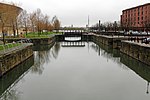Wheel of Liverpool

The Wheel of Liverpool is a transportable Ferris wheel installation on the Keel Wharf waterfront of the River Mersey in Liverpool. It was dismantled refurbishment in the Netherlands in November 2020 and rebuilt in Spring 2021. The wheel is near to M&S Bank Arena Liverpool, and was originally opened on 25 March 2010. The structure is 196 feet (60 m) tall, weighing 365 tonnes and has 42 fully enclosed capsules attached. The wheel had been planned for three years by the company Great City Attractions. They submitted a planning application which explained that it would increase tourism in Liverpool. A smaller observation wheel had been operational in the city, which was located at the Liverpool One leisure complex. This was dismantled because of the plans to open the Wheel of Liverpool. Construction was completed on 11 February 2010 at a cost of £6 million. The wheel was closed for a short time following Great City Attractions going into administration. Freij Entertainment International purchased the attraction and it is operated by their subsidiary Wheels Entertainments Ltd. In November of 2020 Freij Entertainment International dismantled the wheel without warning or explanation. This was later explained as a planned refurbishment. The wheel was rebuilt in Spring of 2021 and reopened in the summer of 2021. In October 2013, the Wheel of Liverpool was struck by lightning but did not sustain any damage.
Excerpt from the Wikipedia article Wheel of Liverpool (License: CC BY-SA 3.0, Authors, Images).Wheel of Liverpool
Keel Wharf, Liverpool Baltic Triangle
Geographical coordinates (GPS) Address Website External links Nearby Places Show on map
Geographical coordinates (GPS)
| Latitude | Longitude |
|---|---|
| N 53.39824 ° | E -2.99083 ° |
Address
Wheel of Liverpool
Keel Wharf
L3 4EU Liverpool, Baltic Triangle
England, United Kingdom
Open on Google Maps







